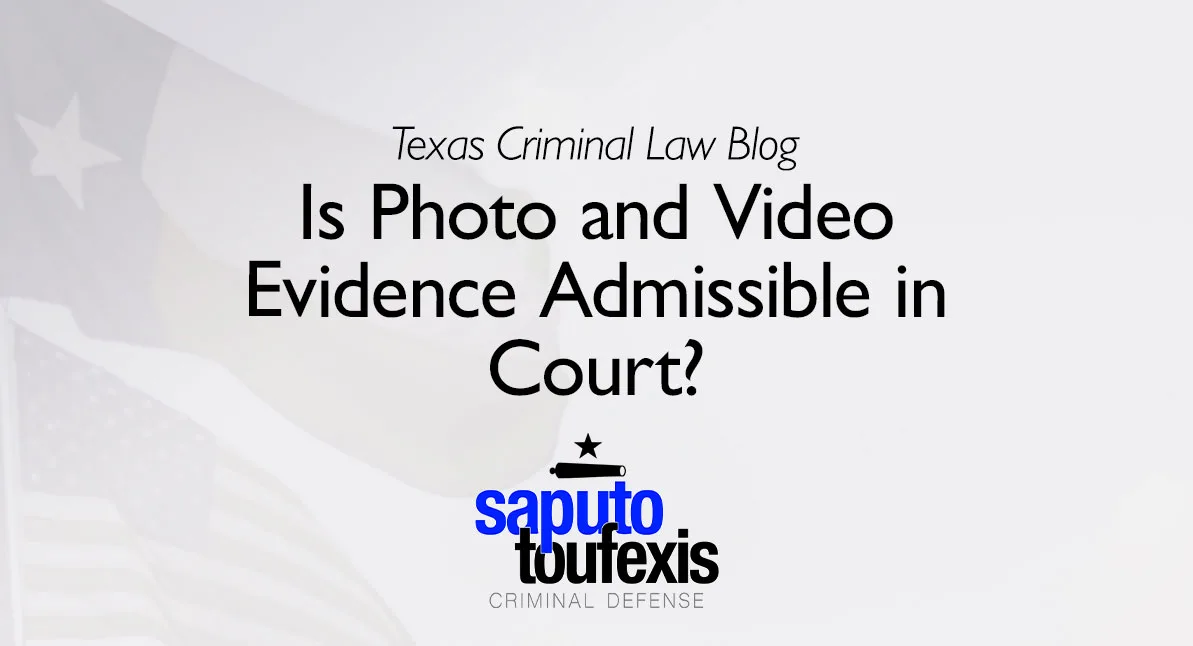In criminal proceedings, people often wonder: is video evidence enough to convict? Visuals like surveillance footage or body camera recordings can play a crucial role in establishing facts, but they must meet strict legal standards to be admissible. Even then, they need to align with the “beyond reasonable doubt” threshold, usually alongside other proof. It’s not just about having the footage—it’s about proving it’s reliable and relevant.
As of August 20, 2025, Texas law emphasizes scrutiny for photo and video evidence to ensure fairness in today’s digital age. If you’re asking “Is video evidence admissible in court?” For dealing with such evidence in a case, this guide covers requirements, objections, and its weight compared to testimony—remember, this is general; consult a criminal defense lawyer for your situation.
At Saputo Toufexis Criminal Defense PLLC, we handle cases where visual evidence is key, challenging its admission when flawed and using it to our clients’ advantage when strong. Our experience in Texas criminal defense helps navigate these issues to protect your rights.
Understanding Admissibility of Photo and Video Evidence
Photo and video evidence can be compelling evidence, but courts in many jurisdictions require it to be relevant, properly authenticated, and not unfairly prejudicial. Relevance means it helps prove or disprove facts in the case, like showing a defendant’s actions during a crime. Authentication comes from witness testimony—perhaps the person who recorded it or an expert confirming no alterations.
The chain of custody is vital too, tracking how the evidence was handled to prevent tampering claims. In Texas, under the Evidence Code, visual documentation from security cameras or police encounters must meet these to be deemed admissible. If legally obtained and maintained, it’s often allowed; otherwise, it’s out.
Surveillance video or body worn cameras on law enforcement officers provide real-time views, but the party presenting the evidence bears the burden to show it’s a true depiction. Without that, judges exclude it to avoid misleading the jury.
Common Scenarios Where Visual Evidence Comes Into Play
These types of evidence show up in all sorts of cases. For example, in personal injury cases, photos of injuries taken right after can support claims if authenticated. Surveillance footage from security cameras might capture a theft, making it automatically admissible if a custodian verifies it’s unaltered.
In criminal investigations, body cameras or video recording from police stops offer objective looks, but if obtained violating privacy laws, they’re barred. We’ve seen social media platforms yield photos that cast doubt on stories, but they need proper authentication to avoid hearsay issues.
Criminal cases often involve video footage showing altercations—clear recordings can be pivotal, but blurry or incomplete ones face challenges. Law enforcement personnel rely on such evidence for warrants if it establishes probable cause, like suspicious activity caught on camera.
Incomplete context can make visuals unfairly prejudicial, turning a neutral clip into something misleading. Defense attorneys scrutinize for that, ensuring only reliable proof enters.
Steps to Admit or Challenge Visual Evidence
If you’re the one presenting video evidence, start by gathering authentication: get testimony from the recorder or an expert on its accuracy. Document the chain of custody from capture to court to prove no tampering. File motions to admit video evidence, showing relevance to the facts.
To challenge, object on grounds like lack of foundation or alteration—perhaps the footage is edited, missing timestamps, or from unauthorized sources. In Texas, if illegally obtained, suppression motions keep it out. The judge decides if it’s admissible in court, weighing probative value against prejudice.
For photos, similar steps: authenticate via someone familiar with the scene, ensure they’re not altered. Criminal procedure allows pre-trial hearings to hash this out, preventing surprises.
Our team guides clients through this, building arguments to include helpful visuals or exclude damaging ones.
Potential Outcomes When Using Visual Evidence
When admitted, photo and video evidence can sway outcomes dramatically. Clear surveillance video proving guilt might lead to conviction if it meets beyond reasonable doubt alone, though rarely—prosecution usually adds testimony. In defense, visuals showing innocence can result in acquittals or dismissals.
But is video evidence enough to convict? It can be if unchallenged and direct, but quality matters—grainy footage needs corroboration. Photo evidence is supportive but lacks motion, so it’s seldom enough solo; it can corroborate but needs explanation for intent.
Outcomes depend on the full picture: strong visuals tip scales, but weak ones get dismissed as inadmissible. In warrants, video footage suffices for probable cause if reliable.
Challenges with Photo and Video Evidence
Admitting these isn’t straightforward. Common objections include blurry recordings or suspected edits that undermine authenticity. If the chain of custody breaks, claims of fabrication arise, making it deemed inadmissible.
Privacy laws exclude illegally obtained material, and incomplete clips can be unfairly prejudicial by lacking context. What type of evidence cannot be used in court? Anything tampered, like under Texas Tampering With or Fabricating Physical Evidence law, or irrelevant items.
Photos might not qualify if unauthenticated or misleading—graphic ones inflaming juries without value get barred. Defense can argue the defendant claims alteration, casting doubt. In today’s digital age, it’s easier to question visuals, demanding solid proof.
These hurdles protect fairness but complicate cases—expert testimony often counters, but not always.
How Saputo Toufexis Criminal Defense PLLC Can Help
We’ve tackled numerous cases involving photo and video evidence in Texas, from surveillance cameras in thefts to body cameras in arrests. We scrutinize for flaws: was it legally obtained? Is the chain of custody intact? We file motions to suppress inadmissible pieces or authenticate helpful ones.
In criminal trials, we challenge the prosecution’s visuals, arguing they’re not compelling evidence without support. For clients, we build defenses showing reasonable doubt, perhaps via counter-testimony or experts. Every scenario differs, so we review your criminal history and evidence to tailor strategies.
Whether presenting video evidence or fighting it, our goal is the best resolution—dismissal, reduced charges, or acquittal. Contact us for insight on your legal proceedings.
Important Facts About Texas Laws on Visual Evidence
In Texas, video evidence is admissible if relevant and authenticated, but the burden is on the presenting party. Surveillance footage needs a custodian’s word it’s unaltered. Photos from social media platforms require similar checks.
No fixed cost or amount needed—quality trumps quantity for beyond reasonable doubt. Law enforcement officers’ body cameras are often key, but privacy laws apply. Visual evidence alone rarely convicts; it needs layering with witness accounts.
Recent case law stresses chain of custody, ensuring no breaks for admissibility.
Common Issues with Photo and Video Evidence
Problems arise when footage lacks timestamps or seems edited, leading to exclusion. Incomplete recordings create bias, like showing only one party’s actions. Security camera footage might be grainy, failing to establish facts clearly.
In police encounters, if obtained without warrant where needed, it’s out. Defense attorneys often spot these, arguing it’s not relevant evidence. Cast doubt by questioning context—does it prove intent?
Such evidence can backfire if unfairly prejudicial, inflaming juries. In personal injury cases or crimes, ambiguous photos need expert testimony to clarify, or they’re sidelined.
Taking the Next Step
If you’re facing questions like is video evidence enough to convict or dealing with photo and video evidence in court, you don’t have to figure it out alone. Our texas criminal defense team at Saputo Toufexis is here to evaluate and strategize.
Reach out today for a free consultation. We’ll help ensure fair treatment in your case.
Saputo Toufexis Criminal Defense PLLC fights for justice with evidence on your side. Let us assist. Visit https://saputo.law or call 888-239-9305.









